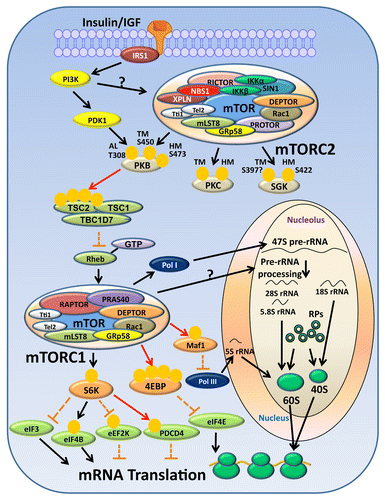Figures & data
Figure 1. Pathway upstream and downstream of mTOR complexes in response to insulin/IGF stimulation and the regulation of protein synthesis by mTORC1. Insulin/IGF activates mTORC1 through IRS-PI3K-PKB pathway which in turn inhibits the GAP activity of TSC complex toward Rheb, allowing Rheb to activate mTORC1. How PI3K leads to mTORC2 activation remains to be investigated. mTORC2’s downstream targets include PKB, PKC and SGK. mTORC1 may regulate several steps in mRNA translation through its substrates S6K (and its own substrates) and 4E-BP1/2. For instance, eIF3, eIF4B, PDCD4 and eIF4E are implicated in the initiation step of translation, whereas eEF2K is involved in translation elongation. mTORC1 also positively regulates ribosome biogenesis, and this can be mediated through the activation of RNA polymerases and the processing of 47S pre-rRNA. Black arrows: positive effect or activation; red lines: phosphorylation events causing a negative effect or inactivation; discontinuous orange lines: an inhibitory mechanism inactivated in response to upstream stimulation. We indicate all the proteins reported to associate with mTORC1/2, but do not intend to imply all are necessarily associated simultaneously.

Table 1. List of mTOR complex components and their contribution to substrate recognition or complex activity
Figure 2. Negative and possible positive feedback mechanisms of the mTOR complexes. (A) Negative feedback loops in insulin/IGF signaling. This includes (i) the stabilization of Grb10 by mTORC1; (ii) the inhibition of IRS1 by S6K1, or ubiquitination and degradation of IRS1 induced by mTORC2; and (iii) SIN1 phosphorylation by S6K1. (B) Potential positive feedback mechanisms of the mTOR complexes. This includes upregulation of IGF2 mRNA translation via the phosphorylation and stimulation of IMPs; mTORC1 increases the synthesis of ribosomes which promote mTORC2 activity; and the phosphorylation of SIN1 at Ser260 by mTOR, which is required for mTORC2 complex assembly and activation. Black arrows: upregulation or phosphorylation event leads to activation; red arrows: downregulation or phosphorylation event leading to inactivation; red “T” lines: inhibition of the phosphorylation event which leads to inactivation; discontinuous orange lines: an inhibitory mechanism released in response to upstream stimulation.

